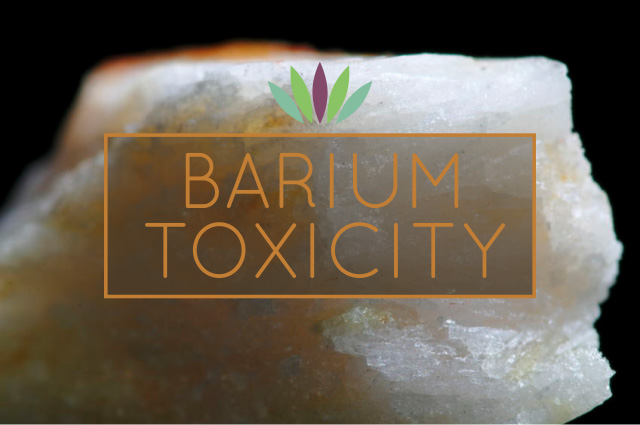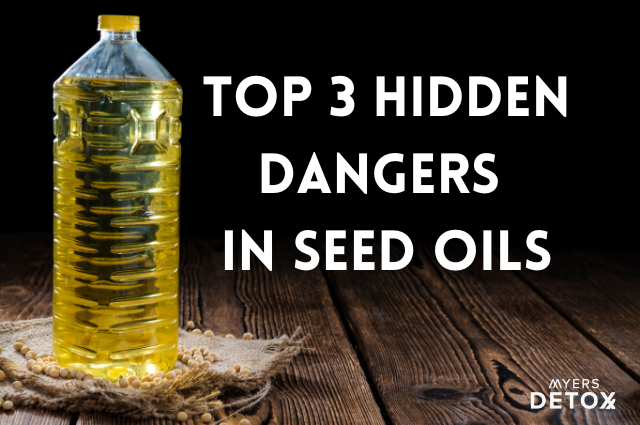Barium is a metal used in medical tests and makes its way into your body from pollution. Learn how to reduce your exposure to this toxic metal and protect your health by detoxing form every day living! All in this article…
Toxic elements, like barium, replace nutrient minerals in enzyme binding sites. When this occurs, the metals inhibit, over-stimulate, or otherwise alter thousands of enzymes. An affected enzyme may operate at 5% of normal activity. This may contribute to many health conditions. Toxic metals may also replace other substances in other tissue structures. The replacement weakens these tissues, such as the arteries, joints, bones, and muscles. Toxic metals may also simply deposit in many sites, causing local irritation and other toxic effects.
Sources of Barium
Barium is found in compounds like barium sulfate, barium oxide, barium hydroxide, barium carbonate, barium chloride, and barium nitrate, just to name a few.
Exposure to barium and its compounds can happen a number of ways, including through groundwater contamination, ingestion of insoluble barium, inhalation, exposure to environmental pollution, cigarette smoke, occupational exposure, or even from certain medical procedures (3).
More specifically, barium can be found in such things as (3, 4, 6, 8, 9):
- Cigarette/tobacco smoke
- Paint pigments
- Pyrotechnics (signal flares, fireworks)
- Petroleum production
- Cathode-ray tubes in plasma TVs, LCD (liquid crystal display) TVs, LCD computer monitors, and laptop computers
- Flat panel display devices (FDPs), such as TVs, computers, and smart phones
- Manufacturing of ceramics and some types of glass
- Filler for rubber, plastics, and resins
- Clay slurries used in drilling oil wells
- Paper filler
- Barium sulfate beverages (used in certain medical procedures)
- Rat poison
- Contaminated groundwater
Now let’s talk about a few of the compounds more specifically.
Barium sulfate is a heavy, white, insoluble powder that occurs in nature as part of the mineral barite (4). Nearly 80% of world consumption of barium sulfate is from drilling muds for oil (4). Think of the environmental and groundwater contamination that happens as a result! Additionally, barium sulfate is used as a pigment for paints to create blanc fixe (aka, “permanent white”) and even, in some cases, as filler for paper and rubber.
Barium sulfate is also a good absorber of X-rays, which is why barium sulfate beverages are often used in a number of radiological medical procedures (9). The patient drinks a barium sulfate liquid, as the barium salts are used to improve x-ray imaging and create a contrast in the intestinal tract. The CDC states that barium sulfate can be safely ingested since barium does not dissolve in water (1). Though, I personally, would reduce my risk of exposure to this compound if possible!
Industrial use of barium is also a major concern for our society, due to the potential for massive environmental pollution from this poisonous metal. Other barium compounds, like barium carbonate, are used in the manufacturing of a whole host of products, including flat screen TVs, ceramics, certain types of glass, and computer monitors. In California, the disposal of display devices such as cathode-ray tube TVs and computer monitors has been banned because they are known to contain toxic substances like barium (6). Newer models of flat panel display devices (FDPs) are also considered toxic, though more extensive studies are being conducted to determine the environmental impact of their disposal (6).
Finally, it’s important to know that barium carbonate is the exact compound used in rat poison (3)!
Symptoms of Barium Toxicity
As mentioned earlier, all soluble barium compounds are poisonous to humans. This is most likely because they interfere with the functioning of potassium ion channels in the body (4).
Specific symptoms of barium toxicity include (1, 2, 3):
- Low blood potassium
- Cardiac arrhythmias
- Respiratory issues
- Respiratory failure
- Gastrointestinal dysfunction
- Muscle weakness
- Muscle twitching
- Lesions on lungs
- High blood pressure
- Vomiting
- Abdominal Pain
- Diarrhea
- Hypokalemia
Health Conditions Caused by Barium
As stated in a study conducted by the Department of Internal Medicine at Maricopa Medical Center, “Barium poisoning results from ingestion or inhalation of the acid salts; the most common poisoning occurs after ingestion of the rodenticide barium carbonate” (5).
Barium primarily blocks the acetylcholine-sensitive potassium current in mammals (7). Toxic levels of barium can be responsible for a range of adverse health conditions, including (1, 3):
- Respiratory failure
- Kidney damage
- Neurodegenerative diseases, including multiple sclerosis
- Ventricular dysrhythmias
- Paralysis
- Death
Detecting Barium Exposure
If you think you’ve been exposed to this pollutant and may have high levels of it in your system, I recommended some testing to determine your level of exposure.
First, a Hair Tissue Mineral Analysis (HTMA). HTMA testing measures heavy metal and mineral concentrations in your hair, which is one of the most common places that heavy metals like to hide. It’s a good way to get a highly accurate snapshot of what’s going on in your body without invasive procedures or expensive scans.
The HTMA testing process is simple (you don’t even need to leave your house). You get a digital kit sent to your email, then you send in your hair sample, and get your results within a few weeks. Testing is both accurate and comprehensive –– an HTMA test will give you information about a wide variety of heavy metals.
Once you have your HTMA test results, you can look at them with a trained practitioner and come up with a personalized plan to support your body’s natural detoxification.
When reviewing the results of your Hair Mineral Analysis, remember that the ideal hair barium level is about 0.03 to 0.05 mg% (10).
If you think you’ve been exposed to health hazards like barium and it may be hiding in your system, order a Hair Tissue Mineral Analysis. From there, you can plan your next steps to reclaim your vitality.
Takeaway
Presently, humanity is exposed to the highest levels of toxic metals in recorded history, up to several thousand times higher than even several hundred years ago due to industrialization. The danger of toxic metals in our environment is greatly aggravated due to low mineral content of our food supply, as well as the contamination of our food supply. If one does not consume preferred minerals in the diet, the body will pick up whatever toxic metals it can from the food, air, and water as substitutes. A key principle to remember is that an abundance of essential minerals in the diet protects the body against toxic metals.
If you are concerned about barium exposure, an HTMA is a great place to start. It can give you the information you need to address the root causes of physical and mental health issues. If you suspect you have a build-up of toxins or a micronutrient imbalance, or you have unexplained symptoms like brain fog, weight gain, fatigue, or hair loss, you will certainly benefit from getting an HTMA.
After a long search and after having worked with multiple labs, I send all of our hair samples to an internationally-recognized lab that is a world leader in HTMA laboratory services. They’ve run more than 100,000 tests, and they process hair samples without washing them, which sets them apart from many other labs (washing a sample removes minerals, which leads to inaccurate results for proper interpretation).
If you think you may have toxin build-up or a mineral imbalance and you want definitive, accurate data on your health, you can order your HTMA here.
*These statements have not been reviewed by the FDA. A Hair Mineral Analysis (HTMA) is not intended to diagnose, treat, cure, reverse, or prevent any disease. It is not intended to replace any other medical test(s) that may be prescribed by your medical doctor.









